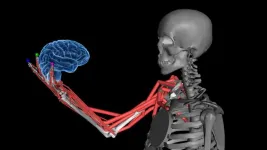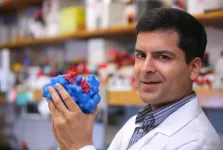(Press-News.org)
Images
A new way to make an important ingredient for plastics, adhesives, carpet fibers, household cleaners and more from natural gas could reduce manufacturing costs in a post-petroleum economy by millions of dollars, thanks to a new chemical reactor designed by University of Michigan engineers.
The reactor creates propylene, a workhorse chemical that is also used to make a long list of industrial chemicals, including ingredients for nitrile rubber found in automotive hoses and seals as well as blue protective gloves. Most propylene used today comes from oil refineries, which collect it as a byproduct of refining crude oil into gasoline.
As oil and gasoline fall out of vogue in favor of natural gas, solar, and wind energy, production of propylene and other oil-derived products could fall below the current demand without new ways to make them.
Natural gas extracted from shale holds one potential alternative to propylene sourced from crude oil. It's rich in propane, which resembles propylene closely enough to be a promising precursor material, but current methods to make propylene from natural gas are still too inefficient to bridge the gap in supply and demand.
"It's very hard to economically convert propane into propylene," said Suljo Linic, the Martin Lewis Perl Collegiate Professor of Chemical Engineering and the corresponding author of the study published in Science.
"You need to heat that reaction to drive it, and standard methods require very high temperatures to produce enough propylene. At those temperatures, you don't just get propylene but solid carbon deposits and other undesirable products that impair the catalyst. To regenerate the reactor, we need to burn off the solid carbon deposits often, which makes the process inefficient."
The researchers' new reactor system efficiently makes propylene from shale gas by separating propane into propylene and hydrogen gas. It also gives hydrogen a way out, changing the balance between the concentration of propane and reaction products in a way that allows more propylene to be made. Once separated, the hydrogen can also be safely burned away from the propane, heating the reactor enough to speed up the reactions without making any undesirable compounds.
This separation is achieved through the reactor's nested, hollow-fiber membrane tubing. The innermost tube is made up of materials that splits the propane into propylene and hydrogen gas. While the tubing keeps most of the propylene inside the innermost chamber, the hydrogen gas can escape into an outer chamber through pores in a membrane layer of the material. Inside that chamber, the hydrogen gas is controllably burned by mixing in precise amounts of oxygen.
Because the hydrogen can be burned inside the reactor and can operate under higher propane pressures, the technology could allow plants to produce propylene from natural gas without installing extra heaters. A plant that produces 500,000 metric tons of propylene annually could save as much as $23.5 million over other methods starting with shale gas, according to the researchers' estimates. Those savings come on top of the operational savings from burning hydrogen produced in reaction, rather than other fuels.
The research was funded by the U.S. Department of Energy's Office of Basic Energy Sciences, the RAPID Manufacturing Institute and the National Science Foundation.
The reactor materials were studied at the Michigan Center for Materials Characterization. The team is pursuing patent protection with the assistance of U-M Innovation Partnerships and is seeking partners to bring the technology to market.
Suljo Linic is also a professor of integrative systems and design.
Study: Overcoming limitations in propane dehydrogenation by co-designing
catalysts/membrane systems (DOI: 10.1126/science.adh3712)
END
New reactor could save millions when making ingredients for plastics and rubber from natural gas
With oil production dropping, a process using natural gas is needed to avert a shortage of a workhorse chemical used for automotive parts, cleaning products and more
2024-03-21
ELSE PRESS RELEASES FROM THIS DATE:
How the brain senses body position and movement
2024-03-21
How does your brain know the position and movement of your different body parts? The sense is known as proprioception, and it is something like a “sixth sense”, allowing us to move freely without constantly watching our limbs.
Proprioception involves a complex network of sensors embedded in our muscles that relay information about limb position and movement back to our brain. However, little is known about how the brain puts together the different signals it receives from muscles.
A new study led by Alexander Mathis at EPFL now sheds light on the question by exploring how our brains create a cohesive sense of body position and movement. Published in Cell, ...
Species diversity promotes ecosystem stability
2024-03-21
Species diversity promotes ecosystem stability
Biodiversity loss may accelerate ecosystem destabilization
What maintains stability within an ecosystem and prevents a single best competitor from displacing other species from a community? Does ecosystem stability depend upon the presence of a wide variety of species, as early ecologists believed, or does diversity do the exact opposite, and lead to instability, as modern theory predicts?
Resolving a long-standing debate among ecologists
A new study from McGill University and ...
University of Calgary research finds a direct communication path between the lungs and the brain
2024-03-21
University of Calgary researchers have discovered the lungs communicate directly with the brain when there is an infection. Findings show the brain plays a critical role in triggering the symptoms of sickness, which may change the way we treat respiratory infections and chronic conditions.
“The lungs are using the same sensors and neurons in the pain pathway to let the brain know there’s an infection,” says Dr. Bryan Yipp, MD '05, MSc'05, clinician researcher at the Cumming School of Medicine and ...
NSF awards grant for evolution-inspired design of therapeutic RNAs
2024-03-21
A team led by Dr. Samie Jaffrey, the Greenberg-Starr Professor of Pharmacology at Weill Cornell Medicine, has been awarded a three-year, $1.65 million grant for RNA research under a biotechnology-development program run by the U.S. National Science Foundation.
The competitive Molecular Foundations for Biotechnology program funds cutting-edge research that lays the groundwork for future clinical and industrial biotechnologies. The new award is one of nine that have been given to research teams across the United States this year, with funding assistance from the National Institutes of Health, to advance the promise of RNA-based therapeutics and ...
Best way to bust deepfakes? Use AI to find real signs of life, say Klick Labs scientists
2024-03-21
NEW YORK, NY / TORONTO, ON – March, 21, 2024 – Artificial intelligence may make it difficult for even the most discerning ears to detect deepfake voices – as recently evidenced in the fake Joe Biden robocall and the bogus Taylor Swift cookware ad on Meta – but scientists at Klick Labs say the best approach might actually come down to using AI to look for what makes us human.
Inspired by their clinical studies using vocal biomarkers to help enhance health outcomes, and their fascination with sci-fi films like “Blade Runner,” the Klick ...
The protein that protects insulin-producing cells
2024-03-21
Although there are many differences between type 1 diabetes and type 2 diabetes, there are also similarities, such as inflammation of the insulin-producing cells. Researchers at Lund University have studied a protein called C3, which plays a central role in the body’s immune system. The protein is secreted from cells and is found in large quantities in the blood. Previous studies by the same researchers have shown that C3 is also present inside cells and plays an important role there. Now, their latest study in PNAS shows that the protein C3 protects insulin-producing cells from damage and death when it is present ...
World’s first N-channel diamond field-effect transistor
2024-03-21
1. A NIMS research team has developed the world’s first n-channel diamond MOSFET (metal-oxide-semiconductor field-effect transistor). The developed n-channel diamond MOSFET provides a key step toward CMOS (complementary metal-oxide-semiconductor: one of the most popular technologies in the computer chip) integrated circuits for harsh-environment- applications as well as the development of diamond power electronics.
2. Semiconductor diamond has outstanding physical properties such as ultra wide-bandgap energy of 5.5 eV, high carriers mobilities, ...
Adults younger than 40 with ideal heart health had lower heart disease, stroke, and kidney disease risk
2024-03-21
Research Highlights:
A study of nearly 4 million young adults under age 40 in South Korea found that those who had ideal cardiovascular health were nearly two-thirds less likely to develop heart disease, stroke and/or kidney disease during a 12-year follow-up period.
Adults who had low heart health scores at study baseline in 2009-2010 but improved their cardiovascular health thereafter also had a reduced risk of heart disease, stroke or kidney disease compared to people with persistent low heart health scores.
Embargoed until 10:30 a.m. CT/11:30 a.m. ET, Thursday, March 21, 2024
CHICAGO, March 21, 2024 — An ...
CZI launches AI Advisory Group and residency program to accelerate development of virtual cell models
2024-03-21
Today, the Chan Zuckerberg Initiative (CZI) announced several key appointments and a new AI residency program to advance the organization’s AI strategy for science, which is focused on building predictive models of healthy and diseased cells. Several AI experts from academia and industry have joined a newly established AI Advisory Group, which will provide guidance to leaders at CZI and across the Chan Zuckerberg Biohub Network as these organizations work to enable AI at scale for nonprofit life science research. In addition, CZI is launching an AI residency program to develop foundational AI/ML models and tools that will enable ...
Natural molecule found in coffee and human body increases NAD+ levels, improves muscle function during ageing
2024-03-21
A research consortium led by Nestlé Research in Switzerland and the Yong Loo Lin School of Medicine, National University of Singapore (NUS Medicine) made a recent discovery that the natural molecule trigonelline present in coffee, fenugreek, and also in the human body, can help to improve muscle health and function. In an international collaboration among the University of Southampton, University of Melbourne, University of Tehran, University of South Alabama, University of Toyama and University of Copenhagen, the work builds on a previous collaborative ...
LAST 30 PRESS RELEASES:
The vast majority of US rivers lack any protections from human activities, new research finds
Ultrasound-responsive in situ antigen "nanocatchers" open a new paradigm for personalized tumor immunotherapy
Environmental “superbugs” in our rivers and soils: new one health review warns of growing antimicrobial resistance crisis
Triple threat in greenhouse farming: how heavy metals, microplastics, and antibiotic resistance genes unite to challenge sustainable food production
Earthworms turn manure into a powerful tool against antibiotic resistance
AI turns water into an early warning network for hidden biological pollutants
Hidden hotspots on “green” plastics: biodegradable and conventional plastics shape very different antibiotic resistance risks in river microbiomes
Engineered biochar enzyme system clears toxic phenolic acids and restores pepper seed germination in continuous cropping soils
Retail therapy fail? Online shopping linked to stress, says study
How well-meaning allies can increase stress for marginalized people
Commercially viable biomanufacturing: designer yeast turns sugar into lucrative chemical 3-HP
Control valve discovered in gut’s plumbing system
George Mason University leads phase 2 clinical trial for pill to help maintain weight loss after GLP-1s
Hop to it: research from Shedd Aquarium tracks conch movement to set new conservation guidance
Weight loss drugs and bariatric surgery improve the body’s fat ‘balance:’ study
The Age of Fishes began with mass death
TB harnesses part of immune defense system to cause infection
Important new source of oxidation in the atmosphere found
A tug-of-war explains a decades-old question about how bacteria swim
Strengthened immune defense against cancer
Engineering the development of the pancreas
The Journal of Nuclear Medicine ahead-of-print tip sheet: Jan. 9, 2026
Mount Sinai researchers help create largest immune cell atlas of bone marrow in multiple myeloma patients
Why it is so hard to get started on an unpleasant task: Scientists identify a “motivation brake”
Body composition changes after bariatric surgery or treatment with GLP-1 receptor agonists
Targeted regulation of abortion providers laws and pregnancies conceived through fertility treatment
Press registration is now open for the 2026 ACMG Annual Clinical Genetics Meeting
Understanding sex-based differences and the role of bone morphogenetic protein signaling in Alzheimer’s disease
Breakthrough in thin-film electrolytes pushes solid oxide fuel cells forward
Clues from the past reveal the West Antarctic Ice Sheet’s vulnerability to warming
[Press-News.org] New reactor could save millions when making ingredients for plastics and rubber from natural gasWith oil production dropping, a process using natural gas is needed to avert a shortage of a workhorse chemical used for automotive parts, cleaning products and more



